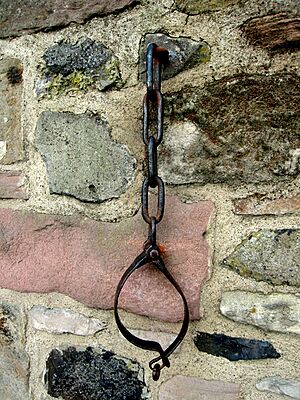Old Scottish Poor Law facts for kids
The Old Scottish Poor Law was Scotland's system for helping people in need between 1574 and 1845. It was a set of rules and laws designed to deal with poverty and people who were struggling to survive.
Contents
What Was the Old Scottish Poor Law?
The Old Scottish Poor Law was a system that aimed to help people who were poor or had no home. It was put in place by the Scottish government and the church, known as the kirk. This system was different from what we have today, as it focused on helping certain groups of people while punishing others.
Why Was This Law Needed?
In the late 1500s, Scotland's population was growing, and many people found it hard to find work or enough food. This led to a lot of people becoming vagrancy, meaning they wandered around without a fixed home or job. The government wanted to control this situation and make sure people were looked after, but also to stop what they saw as "idle" begging.
How Did the Law Work?
The government passed several important laws in 1575, 1579, and 1592. These laws created the basis for the Old Poor Law. The local church (the kirk) played a very big role in making the system work. Local officials, like deacons and elders from the church, were in charge of finding out who needed help.
Helping the "Deserving Poor"
The laws focused on helping the "deserving poor." These were people who truly couldn't work, such as the elderly, the sick, or those with disabilities. Local church officials would make lists of these people and decide how much help they should get. This help often came from money collected by the church.
Dealing with "Sturdy Beggars"
The laws were very strict on what they called "masterful beggars" or "sturdy beggars." These were people who were seen as able to work but chose to beg, or people like jugglers and fortune-tellers who didn't have a license. The laws said these people should be punished. They might be put in the stocks (a wooden device that held their hands and feet) or sent back to the town where they were born. Sometimes, these strict rules actually made it harder for people to find help.
Who Paid for the Help?
For a long time, the money to help the poor came mostly from donations to the church. However, a new law in 1649 changed this. It said that local landowners, called heritors, had to pay a special tax to the church (the kirk session) to help fund the poor relief. This was a bit like a local property tax, and it helped make sure there was enough money to support the system.
How Well Did the System Work?
The Old Scottish Poor Law was generally able to help with everyday poverty and smaller problems. It provided important support for the elderly and sick, helping them survive. However, during very difficult times, like the widespread food shortages in the 1690s, the system struggled to cope with so many people needing help. The Old Poor Law stayed in place until new reforms were introduced in 1845.
See also
- Scottish Poor Law
- Poor Law (Scotland) Act 1845
- Seven ill years


